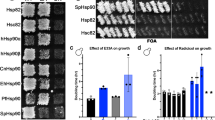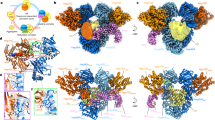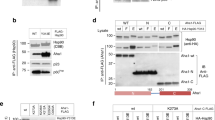Abstract
The molecular chaperone Hsp90 modulates the function of specific cell signaling proteins. Although targeting Hsp90 with the antibiotic inhibitor geldanamycin (GA) may be a promising approach for cancer treatment, little is known about the determinants of Hsp90 interaction with its client proteins. Here we identify a loop within the N lobe of the kinase domain of ErbB2 that determines Hsp90 binding. The amino acid sequence of the loop determines the electrostatic and hydrophobic character of the protein's surface, which in turn govern interaction with Hsp90. A point mutation within the loop that alters ErbB2 surface properties disrupts Hsp90 association and confers GA resistance. Notably, the immature ErbB2 point mutant remains sensitive to GA, suggesting that mature and nascent client kinases may use distinct motifs to interact with the Hsp90 chaperone complex.
This is a preview of subscription content, access via your institution
Access options
Subscribe to this journal
Receive 12 print issues and online access
$189.00 per year
only $15.75 per issue
Buy this article
- Purchase on Springer Link
- Instant access to full article PDF
Prices may be subject to local taxes which are calculated during checkout





Similar content being viewed by others
Accession codes
References
Pratt, W.B. & Toft, D.O. Regulation of signaling protein function and trafficking by the Hsp90/Hsp70-based chaperone machinery. Exp. Biol. Med. 228, 111–133 (2003).
Hernandez, M.P., Sullivan, W.P. & Toft, D.O. The assembly and intermolecular properties of the Hsp70–Hop–Hsp90 molecular chaperone complex. J. Biol. Chem. 277, 38294–38304 (2002).
Murphy, P.J. et al. Visualization and mechanism of assembly of a glucocorticoid receptor. Hsp70 complex that is primed for subsequent Hsp90-dependent opening of the steroid binding cleft. J. Biol. Chem. 278, 34764–34773 (2003).
McLaughlin, S.H., Smith, H.W. & Jackson, S.E. Stimulation of the weak ATPase activity of human Hsp90 by a client protein. J. Mol. Biol. 315, 787–798 (2002).
Panaretou, B. et al. Activation of the ATPase activity of Hsp90 by the stress-regulated cochaperone aha1. Mol. Cell 10, 1307–1318 (2002).
Grenert, J.P. et al. The amino-terminal domain of heat shock protein 90 (Hsp90) that binds geldanamycin is an ATP/ADP switch domain that regulates Hsp90 conformation. J. Biol. Chem. 272, 23843–23850 (1997).
Stebbins, C.E. et al. Crystal structure of an Hsp90–geldanamycin complex: targeting of a protein chaperone by an antitumor agent. Cell 89, 239–250 (1997).
Zhang, W. et al. Biochemical and structural studies of the interaction of cdc37 with Hsp90. J. Mol. Biol. 340, 891–907 (2004).
Sato, S., Fujita, N. & Tsuruo, T. Modulation of Akt kinase activity by binding to Hsp90. Proc. Natl. Acad. Sci. USA 97, 10832–10837 (2000).
Siligardi, G. et al. Regulation of Hsp90 ATPase activity by the co-chaperone Cdc37p/p50cdc37. J. Biol. Chem. 277, 20151–20159 (2002).
Shao, J., Irwin, A., Hartson, S.D. & Matts, R.L. Functional dissection of cdc37: characterization of domain structure and amino acid residues critical for protein kinase binding. Biochemistry 42, 12577–12588 (2003).
Zhao, Q., Boschelli, F., Caplan, A.J. & Arndt, K.T. Identification of a conserved sequence motif that promotes Cdc37 and cyclin D1 binding to Cdk4. J. Biol. Chem. 279, 12560–12564 (2004).
Mimnaugh, E.G., Chavany, C. & Neckers, L. Polyubiquitination and proteasomal degradation of the p185c-erbB-2 receptor protein-tyrosine kinase induced by geldanamycin. J. Biol. Chem. 271, 22796–22801 (1996).
Tikhomirov, O. & Carpenter, G. Geldanamycin induces ErbB-2 degradation by proteolytic fragmentation. J. Biol. Chem. 275, 26625–26631 (2000).
Citri, A. et al. Drug-induced ubiquitylation and degradation of ErbB receptor tyrosine kinases: implications for cancer therapy. EMBO J. 21, 2407–2417 (2002).
Xu, W. et al. Sensitivity of mature Erbb2 to geldanamycin is conferred by its kinase domain and is mediated by the chaperone protein Hsp90. J. Biol. Chem. 276, 3702–3708 (2001).
Slamon, D.J. et al. Human breast cancer: correlation of relapse and survival with amplification of the HER-2/neu oncogene. Science 235, 177–182 (1987).
Anreder, M.B., Freeman, S.M., Merogi, A., Halabi, S. & Marrogi, A.J. p53, c-erbB2, and PCNA status in benign, proliferative and malignant ovarian surface epithelial neoplasms: a study of 75 cases. Arch. Pathol. Lab. Med. 123, 310–316 (1999).
Suda, Y. et al. Induction of a variety of tumors by c-erbB2 and clonal nature of lymphomas even with the mutated gene (Val659→Glu659). EMBO J. 9, 181–190 (1990).
Craft, N., Shostak, Y., Carey, M. & Sawyers, C.L. A mechanism for hormone-independent prostate cancer through modulation of androgen receptor signaling by the HER-2/neu tyrosine kinase. Nat. Med. 5, 280–285 (1999).
Yu, D.H. & Hung, M.C. Expression of activated rat neu oncogene is sufficient to induce experimental metastasis in 3T3 cells. Oncogene 6, 1991–1996 (1991).
Kumar, R. & Yarmand-Bagheri, R. The role of HER2 in angiogenesis. Semin. Oncol. 28, 27–32 (2001).
Liu, S. et al. Genetic instability favoring transversions associated with ErbB2-induced mammary tumorigenesis. Proc. Natl. Acad. Sci. USA 99, 3770–3775 (2002).
Dowsett, M. Overexpression of HER-2 as a resistance mechanism to hormonal therapy for breast cancer. Endocr. Relat. Cancer 8, 191–195 (2001).
Muthuswamy, S.K., Gilman, M. & Brugge, J.S. Controlled dimerization of ErbB receptors provides evidence for differential signaling by homo- and heterodimers. Mol. Cell. Biol. 19, 6845–6857 (1999).
Miller, P. et al. Depletion of the erbB-2 gene product p185 by benzoquinoid ansamycins. Cancer Res. 54, 2724–2730 (1994).
An, W.G., Schulte, T.W. & Neckers, L.M. The heat shock protein 90 antagonist geldanamycin alters chaperone association with p210bcr-abl and v-src proteins before their degradation by the proteasome. Cell Growth Differ. 11, 355–360 (2000).
Tikhomirov, O. & Carpenter, G. Identification of ErbB-2 kinase domain motifs required for geldanamycin-induced degradation. Cancer Res. 63, 39–43 (2003).
Hartmann-Petersen, R., Seeger, M. & Gordon, C. Transferring substrates to the 26S proteasome. Trends Biochem. Sci. 28, 26–31 (2003).
Stamos, J., Sliwkowski, M.X. & Eigenbrot, C. Structure of the epidermal growth factor receptor kinase domain alone and in complex with a 4-anilinoquinazoline inhibitor. J. Biol. Chem. 277, 46265–46272 (2002).
Xu, W., Mimnaugh, E.G., Kim, J.S., Trepel, J.B. & Neckers, L.M. Hsp90, not Grp94, regulates the intracellular trafficking and stability of nascent ErbB2. Cell Stress Chaperones 7, 91–96 (2002).
Isaacs, J.S., Xu, W. & Neckers, L. Heat shock protein 90 as a molecular target for cancer therapeutics. Cancer Cell 3, 213–217 (2003).
Meyer, P. et al. Structural and functional analysis of the middle segment of Hsp90: implications for ATP hydrolysis and client protein and cochaperone interactions. Mol. Cell 11, 647–658 (2003).
Scroggins, B.T. et al. High affinity binding of Hsp90 is triggered by multiple discrete segments of its kinase clients. Biochemistry 42, 12550–12561 (2003).
Miyata, Y. & Nishida, E. CK2 controls multiple protein kinases by phosphorylating a kinase-targeting molecular chaperone, Cdc37. Mol. Cell. Biol. 24, 4065–4074 (2004).
Shao, J., Prince, T., Hartson, S.D. & Matts, R.L. Phosphorylation of serine 13 is required for the proper function of the Hsp90 co-chaperone, Cdc37. J. Biol. Chem. 278, 38117–38120 (2003).
Chavany, C. et al. p185erbB2 binds to GRP94 in vivo. Dissociation of the p185erbB2/GRP94 heterocomplex by benzoquinone ansamycins precedes depletion of p185erbB2. J. Biol. Chem. 271, 4974–4977 (1996).
Tang, C.L. et al. On the role of structural information in remote homology detection and sequence alignment: new methods using hybrid sequence profiles. J. Mol. Biol. 334, 1043–1062 (2003).
Xiang, Z. & Honig, B. Extending the accuracy limits of prediction for side-chain conformations. J. Mol. Biol. 311, 421–430 (2001).
Xiang, Z., Soto, C.S. & Honig, B. Evaluating conformational free energies: the colony energy and its application to the problem of loop prediction. Proc. Natl. Acad. Sci. USA 99, 7432–7437 (2002).
Yang, A.S. & Honig, B. An integrated approach to the analysis and modeling of protein sequences and structures. III. A comparative study of sequence conservation in protein structural families using multiple structural alignments. J. Mol. Biol. 301, 691–711 (2000).
Nicholls, A., Sharp, K.A. & Honig, B. Protein folding and association: insights from the interfacial and thermodynamic properties of hydrocarbons. Proteins 11, 281–296 (1991).
Author information
Authors and Affiliations
Corresponding author
Ethics declarations
Competing interests
The authors declare no competing financial interests.
Supplementary information
Supplementary Fig. 1
Alignment of the amino acid sequence of ErbB1 and ErbB2 kinase domain regions. (PDF 383 kb)
Supplementary Fig. 2
Ribbon diagram of the superimposed kinase domains of ErbB1 and ErbB2. (PDF 1233 kb)
Supplementary Fig. 3
Structure of the M5 loop of ErbB1, ErbB2 and ErbB2-G778N, showing the two trapped water molecules. (PDF 948 kb)
Rights and permissions
About this article
Cite this article
Xu, W., Yuan, X., Xiang, Z. et al. Surface charge and hydrophobicity determine ErbB2 binding to the Hsp90 chaperone complex. Nat Struct Mol Biol 12, 120–126 (2005). https://doi.org/10.1038/nsmb885
Received:
Accepted:
Published:
Issue Date:
DOI: https://doi.org/10.1038/nsmb885
This article is cited by
-
Hsp90 and phosphorylation of the Slt2(Mpk1) MAP kinase activation loop are essential for catalytic, but not non-catalytic, Slt2-mediated transcription in yeast
Cell Stress and Chaperones (2022)
-
Melatonin potentiates the cytotoxic effect of Neratinib in HER2+ breast cancer through promoting endocytosis and lysosomal degradation of HER2
Oncogene (2021)
-
Targeting the interaction of AIMP2-DX2 with HSP70 suppresses cancer development
Nature Chemical Biology (2020)
-
SORLA regulates endosomal trafficking and oncogenic fitness of HER2
Nature Communications (2019)
-
Requirement of HDAC6 for activation of Notch1 by TGF-β1
Scientific Reports (2016)



